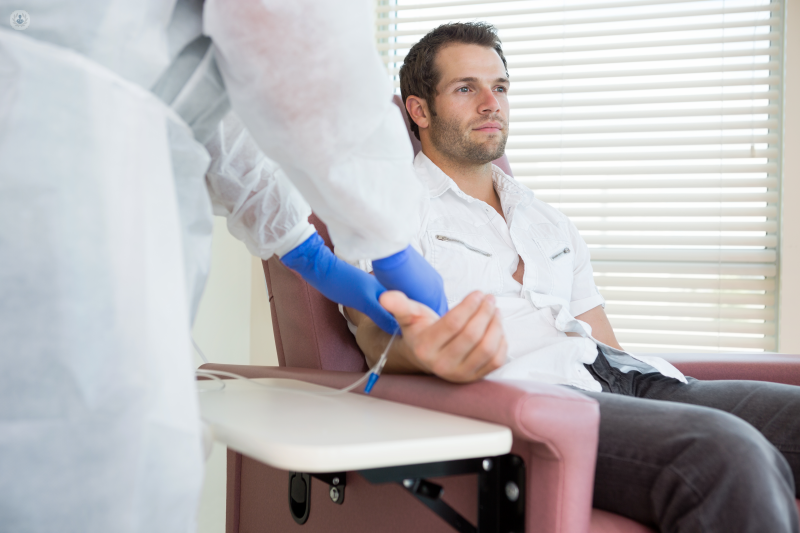Understanding thrombophlebitis
Written by:Thrombophlebitis literally means inflammation of a vein due to a thrombus (blood clot). In medical terms, there are several clues in the name that tell you what this condition is.
- “itis” usually means “inflammation of”
- “phleb” means “vein”
- “thrombo” means “thrombus” which is a blood clot within a blood vessel, such as a vein.
Many people misuse the word “phlebitis” to mean anything from a painful, hard, red lump appearing where there used to be a vein (which is superficial venous thrombophlebitis) all the way through to inflammation around the ankle which is usually lipodermatosclerosis caused by varicose veins or hidden varicose veins.
Professor Mark Whiteley tells us exactly what thrombophlebitis is and the different types that exist.

What happens when someone has thrombophlebitis?
When someone has thrombophlebitis, blood clots within the vein and this irritates the vein wall. In some cases, it is inflammation of the vein wall that causes the blood to clot to form within the vein. Either way, a thrombus or blood clot is formed in the vein and as part of the healing process, the vein wall becomes inflamed. Together these factors cause the vein to become hard, tender, red and hot.
Why does thrombophlebitis happen?
Blood should flow normally through veins and should not clot. The reasons that blood might clot in a vein were first described by Virchow. His “triad” explains that blood can clot in blood vessels if there are any of the following:
- changes in the blood vessel wall
- changes in the blood flow
- changes in the blood constituents
Are there different types of thrombophlebitis?
Generally, in the veins, the different types of thrombophlebitis are:
Superficial Thrombophlebitis
This occurs when blood clots in a superficial vein. Some doctors point out that it should be called “superficial venous thrombosis” to remind doctors and nurses to treat it as a blood clot that is causing inflammation and not as an infected vein.
The commonest superficial thrombophlebitis occurs when varicose veins have been left untreated. The vein wall is stretched and the blood flow is reversed (venous reflux) - two of the factors in Virchow’s Triad. Only one factor is needed to cause thrombosis!
Many patients who have been in hospital and who have had a drip in their arm will have had superficial thrombophlebitis of the arm vein. The drip irritates the vein wall and the solution put into the drip changes the blood constituents. In this case, the drip irritates the vein, the vein gets hard and inflamed and the drip needs to be replaced elsewhere.

Deep Vein Thrombosis
When blood clots in a deep vein, it is called a deep vein thrombosis (DVT). This usually occurs in the deep veins of the leg or pelvis, but can also occur in the veins of the arm.
The deep veins are larger than superficial veins, so the clots tend to be bigger. As the veins are deep, they cannot be felt as hot, tender lumps and so symptoms and signs appear as aches or pain in the muscle around the vein and often swelling of the limb below the clot.
The major worry about DVT is that the clot can propagate or “break off”. This free clot then flows (“embolises”) through the major veins to the heart and then to the lungs, where it can be life-threatening if not treated quickly. This is called a “pulmonary embolism”.
A long term complication of DVT is post-thrombotic syndrome (PTS). If the DVT is not cleared quickly, the inflammation in the deep vein walls can result in scarring of the deep vein and long term reflux and obstruction. This can result in swollen legs, brown skin changes (hemosiderin) and leg ulcers. However, long term varicose veins can mimic these symptoms, so PTS should only be diagnosed after a duplex scan that has checked both deep and superficial veins.
Migratory Thrombophlebitis (Thrombophlebitis migrans)
Although many articles and textbooks talk about thrombophlebitis “moving from one leg to another”, this does not happen. In migratory thrombophlebitis, there is an underlying systemic problem that changes the blood constituents and so allows different thromboses/clots to appear in different veins around the body.
The systemic problems that can cause migratory thrombophlebitis are usually malignant such as pancreatic or lung cancers.
Superficial vs Deep Vein Thrombosis
Traditionally doctors and nurses have been rigid in their view that superficial thrombophlebitis is a minor condition that can be easily treated with painkillers and support stockings (and often with antibiotics) and that DVT is a major condition that needs imaging (duplex scanning) and anticoagulation.
However, guidelines from both the UK and USA in 2012 reported studies showing that; in patients with superficial thrombophlebitis, if the clot was within 5-7cm of a junction with deep veins, 1% of patients went on to get a pulmonary embolism. Hence, it’s recommended that all patients with superficial thrombophlebitis be sent for urgent venous duplex ultrasound scans, and those with blood clots near deep veins should be anticoagulated. Unfortunately for patients, few doctors or nurses follow these guidelines.
If you have varicose veins or red, hard, painful lumps yourself, then book an appointment with Professor Whiteley.


